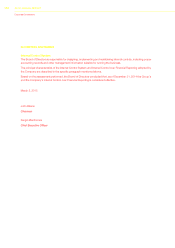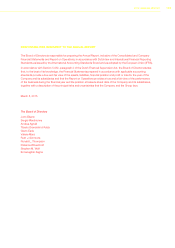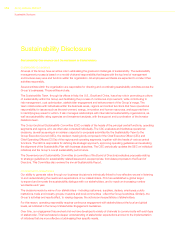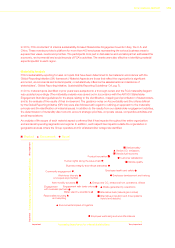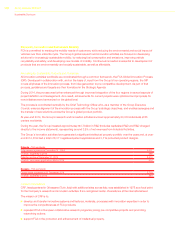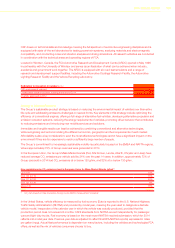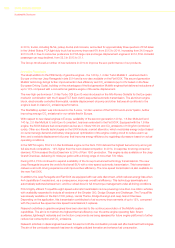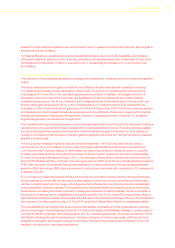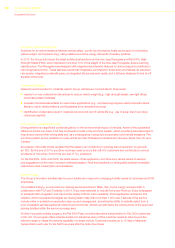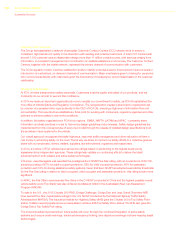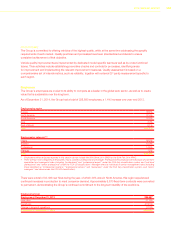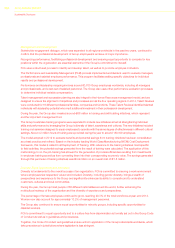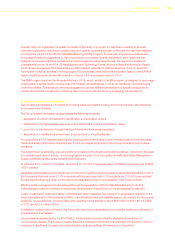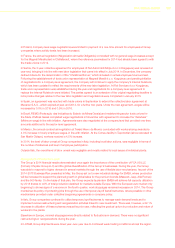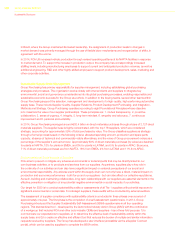Chrysler 2014 Annual Report Download - page 121
Download and view the complete annual report
Please find page 121 of the 2014 Chrysler annual report below. You can navigate through the pages in the report by either clicking on the pages listed below, or by using the keyword search tool below to find specific information within the annual report.
2014 | ANNUAL REPORT 119
Research on after-treatment systems have been focused mainly on passive and active NOx reduction technologies to
address real driving conditions.
For Magneti Marelli, eco-sustainable products (Includes hybrid engine, Xenon and LED headlights, LED tail lights,
GDI injection systems, electronic control modules, automated manual transmissions and components of dual clutch
transmissions) contributed €1.7 billion in revenues for 2014, representing an increase of 21% over the prior year
(€1.41billion).
Natural gas, electric and hybrid solutions
A key element in Group’s emissions reduction strategy is the development of alternatives to the conventional gasoline
engine.
The Group believes that natural gas is currently the most effective and affordable solution available for reducing
CO2 emissions and pollution levels, particularly in urban areas. The level of CO2 emissions from a car running on
natural gas is 23% lower than for an equivalent gasoline-powered vehicle. In addition, natural gas in the form of
biomethane, which is produced from biomass, has significant potential for development as a widely-available
renewable energy source. The Group continued as the undisputed leader in this market sector in Europe with over
56,000 natural gas vehicles sold in 2014 (+34% compared with 2011). In North America, FCA remains the only
automaker to offer a factory-built natural gas pickup, the Ram 2500 Heavy Duty CNG. The Group continued research
and development of technologies that will use natural gas even more efficiently. Advances in engine technology that
leverage the properties of natural gas offer significant potential for achieving solutions to meet the CO2 emissions
targets being phased in across Europe through 2020.
FCA maintained its long-standing leadership in biofuel vehicles in Brazil with more than 680,000 Flexfuel and TetraFuel
vehicles sold in 2014, accounting for approximately 98% of vehicles sold by the Group. Flexfuel technology enables
the use of varying blends of gasoline and bioethanol, while the TetraFuel engine is the first in the world capable of
running on four different fuels: bioethanol, Brazilian gasoline (refined crude oil and 22% anhydrous ethanol), standard
gasoline and natural gas.
The Group is also investing in hybrid and electric vehicle development. The Fiat 500e battery electric vehicle,
launched in the U.S. in 2013 delivers a best-in-class 108 highway MPGe (MPGe is the measure devised by the
U.S. Environmental Protection Agency for determining how many miles an electric vehicle can travel on a quantity
of battery-generated electricity having the same energy content as a gallon of gasoline) rating and a class-leading
87 miles of combined city/highway driving. In 2014, two new plug-in hybrid electric vehicles were announced in the
2014-2018 FCA Business Plan: a Chrysler Town & Country minivan PHEV for 2016 and a Chrysler Full Size Crossover
PHEV. Also included in the Business Plan was the application on a future vehicle of a mild hybrid using belt starter
generator (BSG) technology. BSG offers improvement in fuel economy combined with a reduction in CO2 emissions at
a relatively low cost.
FCA is focused on researching electric/hybrid solutions that are competitive in terms of both cost and performance.
Electric vehicles do not yet offer the same level of advantages for the environment and consumers as natural gas
vehicles. Limitations such as cost, range, recharging speed and infrastructure have thus far prevented widespread
market penetration of electric vehicles. FCA supports public and private sector pilot projects aimed at overcoming
these barriers and testing the market potential for widespread application of electric vehicles. One Group initiative in
this area is a car sharing service, established in conjunction with the City of Turin, where FCA has provided a fleet of
eight all-electric Fiat 500e vehicles. This represents the first test of the Fiat 500e technology in Europe. The Fiat 500e is
also included in the fleet supplied to Expo 2015 by FCA, which is an Official Global Partner for sustainable mobility.
FCA has established partnerships with several government entities, universities and other organizations to develop
electric technologies. Among these is a 5-year, €13.7 million partnership with McMaster University, a public research
university in Hamilton (Canada), with funding support from the Canadian government. The project will advance FCA’s
electrification strategy through the development of multiple prototypes of critical components, platforms and tools
designed to strengthen the Company’s future product lines. The first of three phases was completed in 2014, and
resulted in the filing of four new patent applications.





